The gentamicin API industry stands at the threshold of a decade-long expansion trajectory that promises to reshape antibiotic manufacturing infrastructure and pharmaceutical production technology. The market's journey from USD 2,986.2 million in 2025 to USD 4,599.4 million by 2035 represents substantial growth, demonstrating the accelerating adoption of advanced pharmaceutical manufacturing systems and quality-driven API production solutions across pharmaceutical, biotechnology, and generic drug manufacturing sectors.
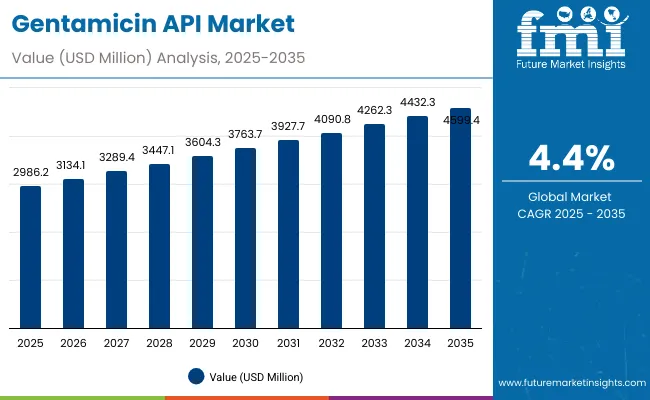
The first half of the decade (2025-2030) will witness the market climbing from USD 2,986.2 million to approximately USD 3,706.0 million, adding USD 719.8 million in value, which constitutes 45% of the total forecast growth period. This phase will be characterized by the rapid adoption of pharmaceutical grade gentamicin sulfate API systems, driven by increasing regulatory compliance requirements and quality assurance concerns worldwide. Advanced manufacturing capabilities and high-purity production features will become standard expectations rather than premium options.
The latter half (2030-2035) will witness sustained growth from USD 3,706.0 million to USD 4,599.4 million, representing an addition of USD 893.4 million or 55% of the decade's expansion. This period will be defined by mass market penetration of crystalline form production systems, integration with comprehensive pharmaceutical manufacturing platforms, and seamless compatibility with existing production infrastructure. The market trajectory signals fundamental shifts in how pharmaceutical and biotechnology companies approach antibiotic API manufacturing, with participants positioned to benefit from sustained demand across multiple application segments.
The Gentamicin API market demonstrates distinct growth phases with varying market characteristics and competitive dynamics. Between 2025 and 2030, the market progresses through its technology adoption phase, expanding from USD 2,986.2 million to USD 3,706.0 million with steady annual increments averaging 4.4% growth. This period showcases the transition from basic API production units to advanced systems with enhanced purification capabilities and integrated quality monitoring systems becoming mainstream features.
The 2025-2030 phase adds USD 719.8 million to market value, representing 45% of total decade expansion. Market maturation factors include standardization of production protocols, declining component costs for purification arrays, and increasing pharmaceutical awareness of high-quality API benefits reaching 85-90% effectiveness in therapeutic applications. Competitive landscape evolution during this period features established manufacturers like ACS DOBFAR SPA expanding their gentamicin API portfolios while new entrants focus on specialized formulations and enhanced purity standards.
From 2030 to 2035, market dynamics shift toward advanced integration and multi-facility deployment, with growth accelerating from USD 3,706.0 million to USD 4,599.4 million, adding USD 893.4 million or 55% of total expansion. This phase transition logic centers on crystalline form production systems, integration with pharmaceutical automation networks, and deployment across diverse manufacturing scenarios, becoming standard rather than specialized applications. The competitive environment matures with focus shifting from basic API capability to comprehensive pharmaceutical manufacturing systems and integration with quality monitoring platforms.
The market demonstrates strong fundamentals with gentamicin sulfate API systems capturing a dominant share through advanced purification and pharmaceutical-grade production capabilities. Pharmaceutical grade applications drive primary demand, supported by increasing facility spending on high-quality API manufacturing systems and therapeutic efficacy management solutions. Geographic expansion remains concentrated in developed markets with established pharmaceutical infrastructure, while emerging economies show accelerating adoption rates driven by manufacturing modernization and rising healthcare awareness.
The gentamicin API market represents a compelling intersection of pharmaceutical manufacturing, quality assurance, and therapeutic efficacy management. With robust growth projected from USD 2,986.2 million in 2025 to USD 4,599.4 million by 2035 at a 4.4% CAGR, this market is driven by increasing regulatory compliance requirements, pharmaceutical infrastructure upgrades, and quality pressures for advanced manufacturing practices.
The market's expansion reflects a fundamental shift in how pharmaceutical and biotechnology companies approach antibiotic API production infrastructure. Strong growth opportunities exist across diverse applications, from generic drug manufacturing requiring reliable quality standards to biotechnology facilities demanding advanced purification capabilities. Geographic expansion is particularly pronounced in Asia-Pacific markets, led by China (7.3% CAGR) and India (7.5% CAGR), while established markets in North America and Europe drive premium positioning and technology innovation.
The dominance of gentamicin sulfate API systems and pharmaceutical grade applications underscores the importance of proven manufacturing technology and operational reliability in driving adoption. Production complexity and quality compliance requirements remain key challenges, creating opportunities for companies that can simplify manufacturing while maintaining quality standards.
Market expansion rests on three fundamental shifts driving adoption across pharmaceutical and biotechnology sectors. Regulatory compliance demand creates compelling operational advantages through pharmaceutical-grade gentamicin API systems that provide consistent quality standards without compromising therapeutic efficacy, enabling facilities to meet stringent regulatory requirements while maintaining production efficiency and reducing compliance costs.
Manufacturing modernization programs accelerate as pharmaceutical operators worldwide seek advanced API production systems that complement traditional manufacturing processes, enabling precise quality control solutions that align with regulatory goals and therapeutic effectiveness requirements. Healthcare infrastructure enhancement drives adoption from pharmaceutical and biotechnology facilities requiring effective antibiotic production solutions that minimize quality variations while maintaining therapeutic standards during high-volume manufacturing operations.
However, growth faces headwinds from production complexity challenges that vary across facility types regarding purification integration and quality control requirements, potentially limiting deployment flexibility in certain manufacturing environments. Technical limitations also persist regarding batch consistency and purification capacity that may increase operational costs in high-volume applications with demanding quality standards.
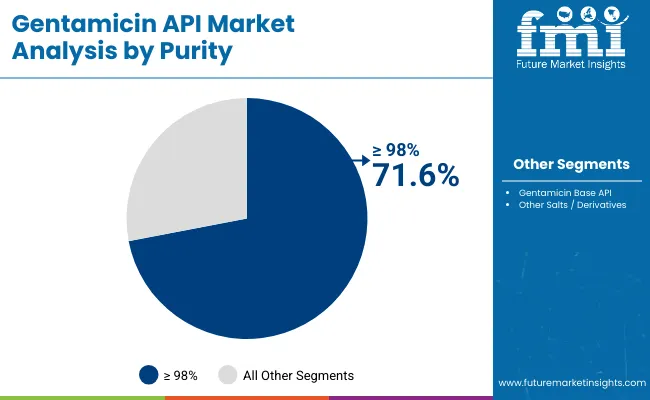
Primary Classification: The market segments by product type into Gentamicin Sulfate API, Gentamicin Base API, and Other Salts/Derivatives categories, representing the evolution from basic API production to advanced pharmaceutical-grade solutions for comprehensive therapeutic applications.
Secondary Breakdown: Purity segmentation divides the market into ≥98% and <97% categories, reflecting distinct requirements for pharmaceutical standards, therapeutic applications, and regulatory compliance.
Tertiary Classification: Grade distribution covers Pharmaceutical Grade API and Technical Grade API sectors, with pharmaceutical applications leading adoption while technical applications show specialized growth patterns driven by research and development programs.
The segmentation structure reveals technology progression from basic gentamicin production systems toward integrated pharmaceutical-grade platforms with enhanced purification and quality monitoring capabilities, while application diversity spans from generic drug manufacturing to biotechnology research requiring precise therapeutic quality management solutions.
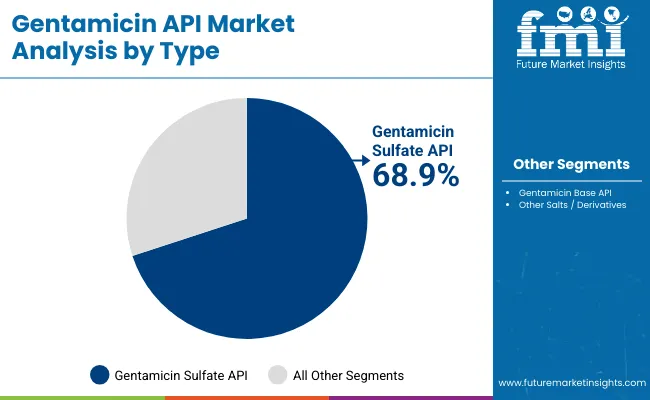
Market Position: Gentamicin Sulfate API systems command the leading position in the Gentamicin API market through advanced pharmaceutical features, including comprehensive therapeutic efficacy, extended stability profiles, and cost-effective manufacturing that enable facilities to deploy reliable antibiotic production solutions across diverse pharmaceutical environments.
Value Drivers: The segment benefits from pharmaceutical preference for proven API technology that provides immediate therapeutic effectiveness without requiring complex formulation modifications. Cost-effective production features enable deployment in pharmaceutical environments, biotechnology facilities, and generic drug applications where reliability and quality consistency represent critical operational requirements.
Competitive Advantages: Gentamicin sulfate systems differentiate through rapid production capability, proven therapeutic performance, and integration with standard pharmaceutical manufacturing systems that enhance facility productivity while maintaining cost-effective operational profiles suitable for diverse pharmaceutical applications.
Key market characteristics
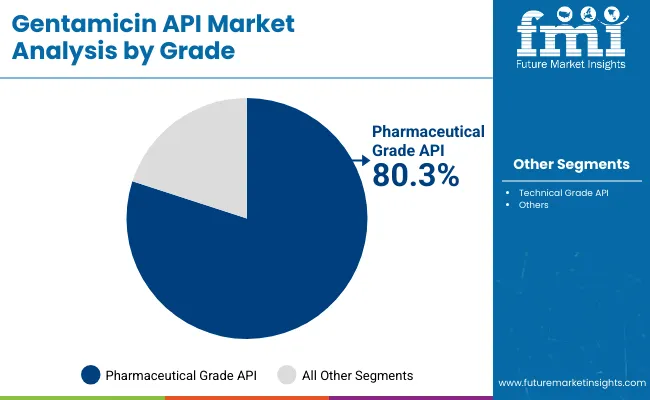
Market Context: Pharmaceutical grade applications dominate the Gentamicin API market due to widespread adoption of high-quality manufacturing systems and increasing focus on therapeutic efficacy management, regulatory compliance, and patient safety applications that ensure therapeutic effectiveness while maintaining operational efficiency.
Appeal Factors: Pharmaceutical customers prioritize system reliability, quality consistency, and integration with existing manufacturing infrastructure that enables coordinated deployment across multiple production facilities. The segment benefits from substantial regulatory compliance budgets and modernization programs that emphasize therapeutic effectiveness for pharmaceutical and biotechnology operations.
Growth Drivers: Manufacturing modernization programs incorporate pharmaceutical-grade API systems as standard equipment for regulatory compliance and therapeutic effectiveness applications. At the same time, pharmaceutical industry initiatives are increasing demand for high-quality manufacturing that comply with regulatory standards and minimize production variations.
Market Challenges: Production requirements and facility compatibility issues may limit deployment flexibility in certain manufacturing scenarios or existing infrastructure applications.
Application dynamics include
Growth Accelerators: Manufacturing modernization drives primary adoption as pharmaceutical-grade gentamicin API systems provide reliable therapeutic capabilities that enable consistent quality production without compromising efficacy, supporting regulatory compliance and operational efficiency that require precise resource management.
Pharmaceutical infrastructure demand accelerates market expansion as manufacturing operators seek effective API production solutions that minimize quality variations while maintaining therapeutic standards during high-volume manufacturing scenarios and compliance operations. Regulatory spending increases worldwide, creating sustained demand for pharmaceutical-grade systems that complement traditional manufacturing processes and provide operational flexibility in complex pharmaceutical environments.
Growth Inhibitors: Production complexity challenges vary across facility types regarding purification integration and quality control requirements, which may limit deployment flexibility and market penetration in facilities with restrictive manufacturing modifications.
Technical performance limitations persist regarding batch consistency and purification capacity that may increase operational costs in high-volume applications with demanding quality standards and frequent production cycles. Market fragmentation across multiple regulatory standards and manufacturing protocols creates compatibility concerns between different system manufacturers and existing facility infrastructure.
Market Evolution Patterns: Adoption accelerates in pharmaceutical and biotechnology sectors where high-quality API production justifies system costs, with geographic concentration in developed markets transitioning toward mainstream adoption in emerging economies driven by manufacturing modernization and pharmaceutical infrastructure development. Technology development focuses on enhanced purification capabilities, improved quality control systems, and integration with manufacturing management platforms that optimize production scheduling and therapeutic quality monitoring. The market could face disruption if alternative antibiotic technologies or regulatory restrictions significantly limit gentamicin API deployment in pharmaceutical or biotechnology applications.
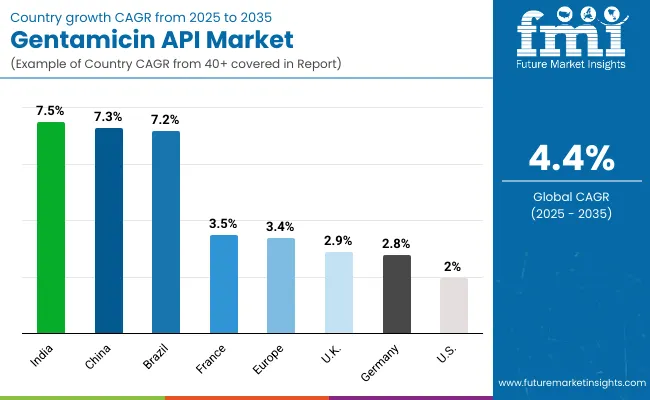
| Country | CAGR (2025 to 2035) |
|---|---|
| India | 7.5% |
| China | 7.3% |
| Brazil | 7.2% |
| France | 3.5% |
| UK | 2.9% |
| Germany | 2.8% |
| USA | 2.0% |
The Gentamicin API market demonstrates varied regional dynamics with Growth Leaders including India (7.5% CAGR) and China (7.3% CAGR) driving expansion through pharmaceutical modernization and manufacturing infrastructure development. Steady Performers encompass Brazil (7.2% CAGR), France (3.5% CAGR), and UK (2.9% CAGR), benefiting from established pharmaceutical sectors and advanced manufacturing adoption. Moderate Growth Markets feature Germany (2.8% CAGR) and the USA (2.0% CAGR), where specialized pharmaceutical applications and regulatory compliance integration support consistent growth patterns.
Regional synthesis reveals Asia-Pacific markets leading growth through pharmaceutical modernization and manufacturing infrastructure development, while European countries maintain steady expansion supported by regulatory compliance advancement and manufacturing modernization requirements. North American markets show moderate growth driven by pharmaceutical facility applications and regulatory integration trends.
India establishes market leadership through aggressive pharmaceutical manufacturing programs and comprehensive API production infrastructure development, integrating advanced gentamicin API systems as standard components in pharmaceutical and biotechnology applications. The country's 7.5% CAGR through 2035 reflects government initiatives promoting pharmaceutical manufacturing and domestic production capabilities that mandate the use of high-quality API systems in pharmaceutical and research installations. Growth concentrates in major pharmaceutical centers, including Mumbai, Hyderabad, and Bangalore, where manufacturing modernization showcases integrated API production systems that appeal to domestic operators seeking advanced quality solutions and operational efficiency applications.
Indian manufacturers are developing cost-effective gentamicin API solutions that combine domestic production advantages with advanced features, including multi-stage purification systems and extended therapeutic effectiveness capacity.
Strategic Market Indicators
In Beijing, Shanghai, and Shenzhen, pharmaceutical and biotechnology facilities are implementing advanced gentamicin API systems as standard equipment for manufacturing operations and regulatory compliance applications, driven by increasing facility spending and modernization programs that emphasize pharmaceutical-grade infrastructure capabilities. The market is projected to demonstrate a 7.3% CAGR through 2035, supported by government pharmaceutical initiatives and manufacturing infrastructure development programs that promote advanced API production systems for pharmaceutical and biotechnology facilities.
Chinese facility operators are adopting gentamicin API systems that provide reliable therapeutic quality management and pharmaceutical manufacturing features, particularly appealing in pharmaceutical developments where regulatory compliance represents critical operational requirements.
Market expansion benefits from growing pharmaceutical manufacturing capabilities and international technology transfer agreements that enable domestic production of advanced API systems for pharmaceutical and biotechnology applications.
Market Intelligence Brief
Brazil's market expansion benefits from diverse pharmaceutical demand, including manufacturing modernization in São Paulo and Rio de Janeiro, biotechnology equipment upgrades, and government pharmaceutical programs that increasingly incorporate high-quality API production solutions for pharmaceutical applications. The country maintains a 7.2% CAGR through 2035, driven by rising regulatory awareness and increasing recognition of gentamicin API technology benefits, including reliable therapeutic quality and improved manufacturing capabilities.
Market dynamics focus on cost-effective gentamicin API solutions that balance advanced purification features with affordability considerations important to Brazilian pharmaceutical operators. Growing pharmaceutical development creates sustained demand for modern API production systems in new manufacturing infrastructure and biotechnology equipment modernization projects.
Strategic Market Considerations
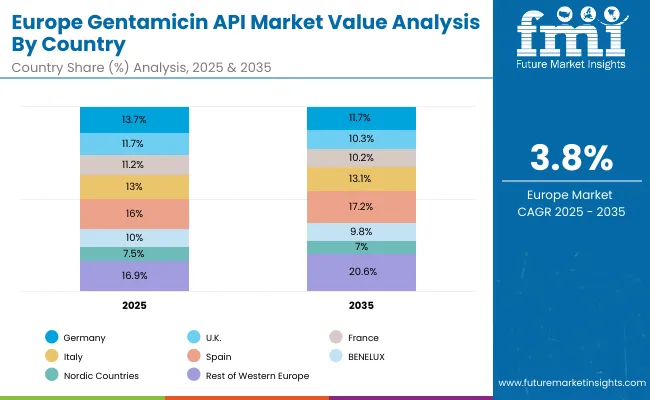
The Gentamicin API market in Europe is projected to grow from USD 519.8 million in 2025 to USD 757.8 million by 2035, registering a CAGR of 3.8% over the forecast period. Spain is expected to maintain its leadership position with a 17.2% market share by 2035, supported by its advanced pharmaceutical infrastructure and major manufacturing centers, including Madrid and Barcelona.
Italy follows with a 13.1% share by 2035, driven by comprehensive pharmaceutical modernization programs and API production development initiatives. Germany holds a 11.7% share by 2035, expected to maintain steady growth through specialized pharmaceutical applications and regulatory compliance requirements. France commands an 10.2% share, while UK accounts for 10.3% by 2035. The Rest of Western Europe region is anticipated to gain momentum, expanding its collective share to 20.6% by 2035, attributed to increasing gentamicin API adoption in Nordic countries and emerging Eastern European pharmaceutical facilities implementing manufacturing modernization programs.
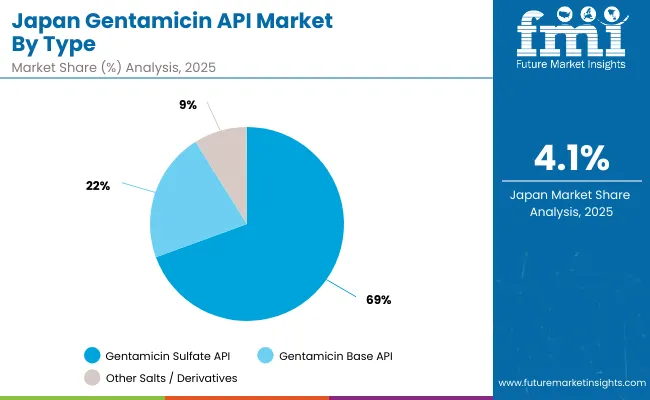
The gentamicin API market in Japan is set to remain concentrated across established API types in 2025, reflecting manufacturing preferences and market demand patterns. Gentamicin Sulfate API dominates with a 69.5% share in 2025, supported by its central role in pharmaceutical formulations, established manufacturing processes, and widespread clinical applications.
Gentamicin Base API represents 21.7% in 2025, maintained by specialized pharmaceutical applications, custom formulation requirements, and specific manufacturing processes. Other Salts/Derivatives account for 8.9%, sustained by niche applications, specialized formulations, and research and development activities.
The market distribution reflects Japan's focus on high-quality pharmaceutical manufacturing, established API production capabilities, and emphasis on meeting stringent quality standards for both domestic and international pharmaceutical applications.
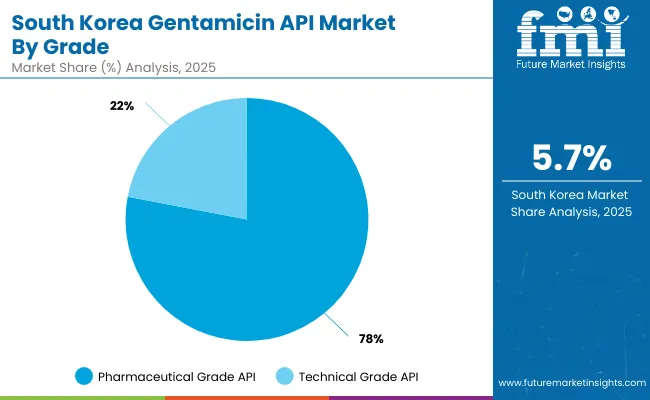
The gentamicin API market in South Korea in 2025 is characterized by grade preferences reflecting pharmaceutical industry priorities and quality requirements. Pharmaceutical Grade API accounts for 78.0%, supported by dominant pharmaceutical manufacturing applications, stringent quality standards, and regulatory compliance requirements for human medicinal products.
Technical Grade API contributes 22.0%, driven by specialized industrial applications, research and development activities, and non-pharmaceutical uses that require lower purity specifications. This segment reflects the diverse applications of gentamicin API beyond human pharmaceutical manufacturing.
The grade distribution highlights South Korea's focus on pharmaceutical-grade API production, commitment to quality manufacturing standards, and balanced approach to serving both pharmaceutical and technical market requirements with appropriate quality specifications.
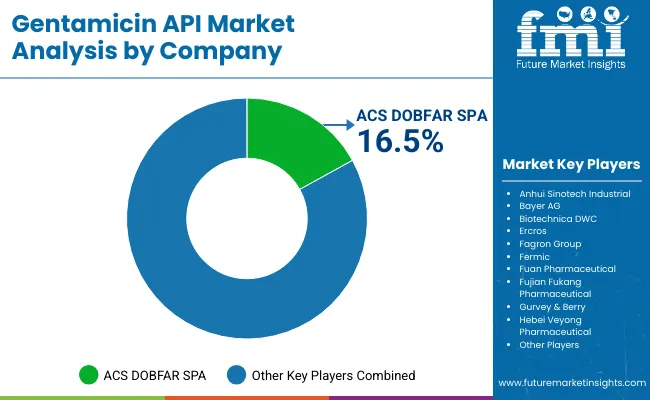
The Gentamicin API market operates with moderate concentration, featuring approximately 25-30 meaningful participants, where leading companies control roughly 35-40% of the global market share through established pharmaceutical facility relationships and comprehensive technology portfolios. Competition emphasizes advanced purification capabilities, system reliability, and manufacturing integration rather than price-based rivalry.
Market Leaders encompass ACS DOBFAR SPA, which maintains competitive advantages through extensive pharmaceutical manufacturing expertise, global API production networks, and comprehensive system integration capabilities that create customer switching costs and support premium pricing. The company leverages decades of pharmaceutical experience and ongoing research investments to develop advanced gentamicin API systems with enhanced purification and manufacturing management features.
Technology Challengers include Anhui Sinotech Industrial, Bayer AG, and Biotechnica, which compete through specialized API technology focus and innovative production interfaces that appeal to pharmaceutical customers seeking advanced therapeutic quality capabilities and operational flexibility. These companies differentiate through rapid technology development cycles and specialized pharmaceutical application focus.
Market dynamics favor participants that combine reliable API production hardware with advanced quality monitoring software, including therapeutic effectiveness tracking and automatic compliance alert capabilities. Competitive pressure intensifies as traditional pharmaceutical manufacturers expand into specialized API systems. At the same time, biotechnology companies challenge established players through innovative purification solutions and cost-effective platforms targeting specialized pharmaceutical segments.
| Item | Value |
|---|---|
| Quantitative Units | USD 2,986.2 Million |
| Product Type | Gentamicin Sulfate API, Gentamicin Base API, Other Salts/Derivatives |
| Purity | ≥98%, <97% |
| Grade | Pharmaceutical Grade API, Technical Grade API |
| Form | Powder, Crystalline Form, Solution |
| Sales Channel | Direct Sales, Distributor Sales, Online/API Marketplaces, Others |
| Regions Covered | North America, Europe, Asia Pacific, Latin America, Middle East & Africa |
| Countries Covered | China, India, Germany, Brazil, the USA, the UK, France, and 25+ additional countries |
| Key Companies Profiled | ACS DOBFAR SPA, Anhui Sinotech Industrial, Bayer AG, Biotechnica, Fagron Group |
| Additional Attributes | Dollar sales by product type and application categories, regional adoption trends across North America, Europe, and Asia-Pacific, competitive landscape with pharmaceutical manufacturers and technology providers, facility preferences for therapeutic quality and system reliability, integration with manufacturing management platforms and compliance systems, innovations in purification technology and production efficiency, and development of pharmaceutical-grade solutions with enhanced therapeutic effectiveness and quality monitoring capabilities. |
The global Gentamicin API market is valued at USD 2,986.2 million in 2025.
The size of the Gentamicin API market is projected to reach USD 4,599.4 million by 2035.
The Gentamicin API market is expected to grow at a 4.4% CAGR between 2025 and 2035.
The key product type segments in the Gentamicin API market are Gentamicin Sulfate API, Gentamicin Base API, and Other Salts/Derivatives.
In terms of product type, the Gentamicin Sulfate API segment is set to command the dominant share in the Gentamicin API market in 2025.






Full Research Suite comprises of:
Market outlook & trends analysis
Interviews & case studies
Strategic recommendations
Vendor profiles & capabilities analysis
5-year forecasts
8 regions and 60+ country-level data splits
Market segment data splits
12 months of continuous data updates
DELIVERED AS:
PDF EXCEL ONLINE
Apigenin Market Size and Share Forecast Outlook 2025 to 2035
API Monetization Platform Market by Component, Enterprise Size, Industry & Region Forecast till 2035
Rapid Microbiology Testing Market Forecast Outlook 2025 to 2035
Rapid Test Cards Market Size and Share Forecast Outlook 2025 to 2035
Rapid Prototyping Materials Market Size and Share Forecast Outlook 2025 to 2035
Rapid Test Readers Market Size and Share Forecast Outlook 2025 to 2035
Papillary Thyroid Cancer Market Size and Share Forecast Outlook 2025 to 2035
Tapioca Pearls Market Analysis - Size, Share, and Forecast 2025 to 2035
Rapid Strength Concrete Market Size and Share Forecast Outlook 2025 to 2035
Rapid Self-Healing Gel Market Size and Share Forecast Outlook 2025 to 2035
Tapioca Maltodextrin Market Analysis - Size, Share, and Forecast Outlook 2025 to 2035
Rapid Infuser Market Size, Growth, and Forecast 2025 to 2035
Capillary Electrophoresis Market Size, Growth, and Forecast 2025 to 2035
Rapid RNA Testing Kits Market Trends- Growth & Forecast 2025 to 2035
Rapid Hepatitis Testing Market – Demand & Forecast 2025 to 2035
Rapid Antigen Testing Market - Demand, Growth & Forecast 2025 to 2035
Tapioca Market Trends - Starch Solutions & Global Demand 2025 to 2035
Market Leaders & Share in the Rapid Infuser Industry
Rapid Plasma Reagin Test Market
Rapid Coagulation Testing Market

Thank you!
You will receive an email from our Business Development Manager. Please be sure to check your SPAM/JUNK folder too.
Chat With
MaRIA